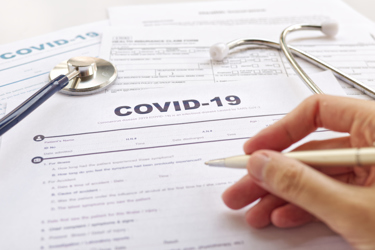COVID-19 And Its Impact On Clinical Trials

By Ed Miseta, Chief Editor, Clinical Leader

Debora Araujo, founder and CEO of ClinBiz, recently hosted a live online discussion on the COVID-19 pandemic and the impact it will have on clinical trials. Participating with Araujo on the call was Rosalie Filling, VP of R&D operations at Endo Pharmaceuticals, Michael Young, principal of biomedwoRx: Life Sciences Consulting, Terry Walsh, owner of Walsh Pharma Consulting, Jeff Kingsley, founder and CEO of IACT Health, and Julie Daves, senior director of clinical operations & outsourcing at miRagen Therapeutics. The purpose of the call was to share knowledge of how the pandemic might impact clinical trials and what sponsor companies can do to adapt.
The first topic the panel tackled was monitoring. The monitoring of patients is perhaps the greatest ongoing challenge sponsors face during the pandemic. Filling noted the challenge for everyone involved with clinical trials will be providing efficient monitoring and oversight for the studies while also keeping patients safe. That will involve discovering new ways to perform those functions.
“In this day and age, we have great technologies available to us,” says Filling. “The good news is many companies were already performing remote and decentralized monitoring. The systems they need are already in place. For the companies that were not already doing that, there are resources available to help. I would also recommend turning to colleagues in the industry to help you navigate those processes.”
Sites Need Help
The situation taking place at many clinical sites seems to be changing day-by-day and even hour-by-hour. Trial monitoring has essentially ground to a halt at many of those clinics as the pandemic has sites focusing on protecting staff and patients. This situation makes remote monitoring essential. Filling believes sponsor companies need to step up and make sure their sites have the funding they need to put a successful remote monitoring approach in place.
“Try to put yourself in their shoes,” she says. “They are dealing with a lot of issues right now. One site could have 15 sponsor companies lined up at their door suddenly asking them for remote monitoring services because it’s what regulators expect. Now is the time to give them the support they need.”
Davies agrees. She recently received a call from a friend who runs a site network asking how they should be handling patient monitoring and if they should even be open.
 Debora S. Araujo, founder and CEO, ClinBiz |
“From a site perspective, this is a crazy time,” says Kingsley. “Half our business has been put on hold, yet our workload is increasing. We are being inundated with phone calls, emails, and requests for updates from every sponsor client. We are dealing with 230 concurrent trials and all have unique requests. I have even spoken with several sponsors that are still demanding on-site visits take place. This is very disruptive. Sites are hurting financially and, suddenly, most of their work is unpaid activities.”
That workload Kingsley refers to is getting on calls with sponsors and CROs, performing remote monitoring visits, and performing other tasks that were not built into the original study budget. Those activities are going to impact site revenue. This is happening at a time when sites must reduce employee hours and even layoff some staff members. Those activities could also have an impact on clinical trials in the future, as it will be harder for sites to ramp up when the impact of the pandemic begins to fade.
“When you are forced to lay off staff, it can be hard to find experienced coordinators when you start re-hiring,” says Kingsley. “That means some sites might be forced to hire inexperienced staff to conduct the trials. I would encourage sponsors to get caught up on payments that might be owed to sites. Sites will need cashflow to weather this storm and continue to perform the requirements of your trial.”
A Site Stimulus
With the federal government considering a stimulus package for businesses and households, pharma might want to consider whether it’s time to discuss a site stimulus package. Some participants agreed that for pharma to salvage the data that exists on its trials, a stimulus is worth considering. That could take the form of a bonus or other financial incentives that would help sites get through this difficult time.
“It saddens me to hear that sponsors aren't thinking about the additional cost implications for sites,” says Filling. “There is a lot of work, cost, and additional training involved with performing remote monitoring. Sponsors need to consider that and help offset the costs. That is the approach we are taking. We are considering everything our sites ask for and going back to them with what we can offer. Sites are our partners, and we will need to work together to get through this crisis.”
One additional staffing issue impacting clinical trials is the availability of therapeutic expertise. Young notes most clinical trials are in oncology, and most oncologists are classified as internal medicine. With the pandemic, many resident and attending staff that can treat COVID-19 patients are being pulled into general medicine clinics.
“They are needed to provide relief for the frontline providers who are running on fumes,” says Young. “We hear about the shortage of masks and other protective equipment, but we do not hear as much about the human dimension and what is happening with the frontline staff. They can only stay at work for so long before needing to rest. When those professionals get exposed to the virus, they must go into quarantine at home, which makes the situation even worse. I have a physician friend in San Diego who has set up a bedroom in her garage to protect her family. That causes a lot of mental stress. These are the stories we don’t hear about, but they will have an impact on clinical momentum.”
Document Everything
The panel agreed this is also a time for sponsors and sites to take a step back and outline their trial priorities. That outline should include what will need to be done to institute remote monitoring and what progress should be made in six months. It should also determine what actions are not essential to the trial and can be put on hold. If the pandemic persists after six months, a new outline will need to be completed. Sponsors should also consider producing a COVID-19 plan for each of their studies and distribute those plans to clinical sites. By putting things on paper there is a written plan for internal teams and sites to follow, which will keep everyone on the same page. Those plans should be fluid as they could be changing daily.
“This is certainly a time for sponsors to try thinking outside the box,” says Walsh. “When looking towards the future, it’s easy for companies to try and stay in a safe zone. One example might be the supply chain and getting products to patients. We need to keep in mind that there is always a patient at the end of that supply chain. The regulatory guidance was written in a way that leaves a lot of doors open for sponsors. Companies can now investigate things like direct–to-patient shipping of clinical supplies. There is a real opportunity as sponsor companies are being presented with unprecedented flexibility.”
The panel also stressed the importance of documenting activities. Everyone agreed that although documenting actions is always important, it is now more important than ever. Guidance recently released by the FDA and EMA gives sponsors increased flexibility, but also stresses the need to document actions. Staffs should be trained to over-document thought processes and be prepared to explain it to regulators later. A good rule: ”If you don’t document it, it didn’t happen.”
Consider The Needs Of Every Patient
Kingsley states his sites are in the process of categorizing all trials, a process that involves examining the needs of the enrolled patients. If a trial involves monoclonal antibodies, for example, staff will determine the immune response of patients and thereby determine which trials present a higher risk for patients. A decision can then be made as to whether to continue the trial and how patients should be monitored. “The level of risk will determine whether patients come to the clinic or if we visit them at home,” says Kingsley.
Best practices that emerge during the pandemic will likely carry forward once COVID-19 has passed. Young hopes remote monitoring will be one of them. “Virtual engagement is where we are going and it will be a positive development for the industry,” he says. “This pandemic is really showing us a picture of what the future is going to look like. Remote monitoring is the tool that will allow us to effectively go to patients and continue to collect as much data as we can.”
Be aware that regulations and guidance differ from country-to-country. Actions in the U.S. may not be permissible in countries in Europe. In some countries, for example, clinic personnel are not permitted to visit a patient’s home. For sites that want to adhere to these regulations, this presents an additional challenge that must be overcome. It is also the perfect time to contact an IRB for advice.
Another consideration to protect the health of study participants would be to have separate waiting rooms. Davies notes hearing of a hospital that was putting all visitors in the same waiting room, including individuals who were in car accidents and those with symptoms of COVID-19.
“If you want to protect your patients that seems like something so simple” she says. “Every hospital or clinic should have two separate areas. That goes a long way towards protecting your patients who are simply there for a monitoring visit. For clinics that are not able to perform home visits that seems like the least they can do.”
Another option is to eliminate waiting rooms altogether. A clinic could have patients call from their car when they arrive, and then wait there until they are ready to be seen by staff members.
The panel also cautions sponsors to not forget about their research naive sites. Filling notes all sponsors have a small handful of sites that might be working on their first or second clinical trial. “This is a crazy time for them,” she says. “They don't know how to deal with what is going on. You are the company that is teaching them how to navigate the research waters. This is a good time to reach out to them and listen to their concerns. They may not know what to do or where to go. You can be a very valuable resource to them right now.”
Finally, getting through this pandemic will certainly necessitate keeping all lines of communication open. For the time being, all kickoff meetings and investigator meetings will certainly be virtual. If you’re a site and have questions, don’t be afraid to ask. There must be an open dialogue between sponsors, sites, and CROs. With additional flexibility coming from the FDA and IRBs, now is the time for everyone to be discussing necessary changes to help patients and keep trials on track. As a sponsor, don’t hesitate to start those discussions.
“The silver lining is that we will be much better at doing this in the future,” says Kingsley. “The pain we are currently experiencing will accelerate the adoption of new technologies and new ways of conducting clinical research. It will change how we design protocols and how we look at contracting and budgeting. The future looks very exciting. We just have to survive today.”
The panel also discussed direct to patient supply chains and clinical trial contracts and budgets. The audio from the webinar can be accessed here. For more information: http://clinbiz.com/
